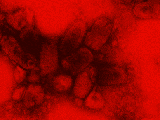 |
SFM VIRUS
VIRAL
PROFILE
The
damage done by a virus can be a general measure of how long a virus has
been infecting a particular species. Violent hemorrhagic viruses such
as Ebola are assumed to have made the jump from animals to humans relatively
recently because they kill their hosts rapidly, and a virus within a dead
host is not able to reproduce or spread itself. At the other end of the
spectrum are symbiotic viruses, which increase the evolutionary fitness
of the host in order to promote its own reproduction.
The extreme advantages conferred upon those infected by this virus suggest that it has been present in humans for hundreds, perhaps thousands, of years. An analysis of historical case studies provides further support for this claim by confirming that the strain has mutated over many generations, developing resistance to substances which may have once slowed or killed it.
INFECTION
& TRANSMISSION
Upon infection, the virus spreads through the bloodstream and interferes
with the body's ability to make hemoglobin. Without hemoglobin, red blood
cells do not form properly and cannot carry sufficient oxygen, causing
a pervasive anemia that requires lifelong blood transfusions. These transfusions
provide the patient with a temporary supply of healthy red blood cells
with normal hemoglobin, capable of carrying the oxygen that the body needs.
Without this treatment subjects become pale, do not sleep well and may
reject solid foods.
Once in the brain, the virus resembles rabies* in that it is programmed to infect the brain centers that induce aggression and the urge to bite others. Simultaneously it infects the salivary glands, where it may be transmitted to others through bites. For these reasons, the name "Sanguinofamia Mordens" or SFM is suggested.
Symbiotic enhancement of the host promotes transmission of the virus in the following ways:
1) Physical - Damage to NMDA receptors disrupts a number of neurotransmitter systems, which includes the disinhibition of dopamine release. Similar to PCP, this produces anesthesia to pain (which promotes a feeling of immortality) as well as mental stimulation (which provides an abnormal awareness of sensations, including sight, smell and sound) This damage increases the subject's physical prowess, and thus his ability to successfully transmit the virus in an attack.
2) Psychological - Damage to ventral frontal lobes results in an emotion-processing disorder in which the subject shows reduced ability to respond to emotional signals derived from faces and voices in social interactions. Subjects are therefore less affected by the emotional responses of their victims, and thus more likely to be able to transmit the virus through an attack.
SYMPTOMS
Initially, a person who is bitten may notice unusual feelings or tingling
around the wound. Soon afterwards there is a period of tiredness, possibly
with lack of appetite, headache, fever, cough, abdominal pain, nausea,
vomiting and sore throat. This is followed by a period of irritability,
sensitivity to bright light and an inability to sleep. In its final stages,
there is an extreme drop in blood pressure, pulse rate and respiration.
CHRONIC
VS. CARRIER STATES
The description above details the illness in its full-blown chronic state
(see Vampires). However, another state has
been discovered. It has been found that simple exposure to the virus by
contact with an infected host (such as being bitten) produces a carrier
state with the same symptoms as the chronic, only to a lesser degree (see
The Hunted).
The key difference between the development of the carrier state (vs. the chronic) appears to be that the subject has retained enough of his own blood to both fight the infection with white blood cells, and manufacture enough healthy hemoglobin to sustain physiological functioning. With the immune system reducing the viral load, the psychological effects such as the urge to bite are reduced; while the limited production of healthy hemoglobin reduces the constant need for fresh blood. However, it is important to note that although reduced, no symptom is entirely absent in the carrier state.
Responsible for this research is Jessica, who receives funding from an unknown source to continue her research and formulate a cure for the virus.
* Taken from the Wikipedia excerpt on vampires:
Rabies has been linked with vampire folklore. Dr Juan Gómez-Alonso, a neurologist at Xeral Hospital in Vigo, Spain, examined this possibility in a report in Neurology. The susceptibility to garlic and light could be due to hypersensitivity, which is a symptom of rabies. The disease can also affect portions of the brain that could lead to disturbance of normal sleep patterns (thus becoming nocturnal) and hypersexuality. Legend once said a man was not rabid if he could look at his own reflection (an allusion to the legend that vampires have no reflection). Wolves and bats, which are often associated with vampires, can be carriers of rabies. The disease can also lead to a drive to bite others and to a bloody frothing at the mouth.[128][129]